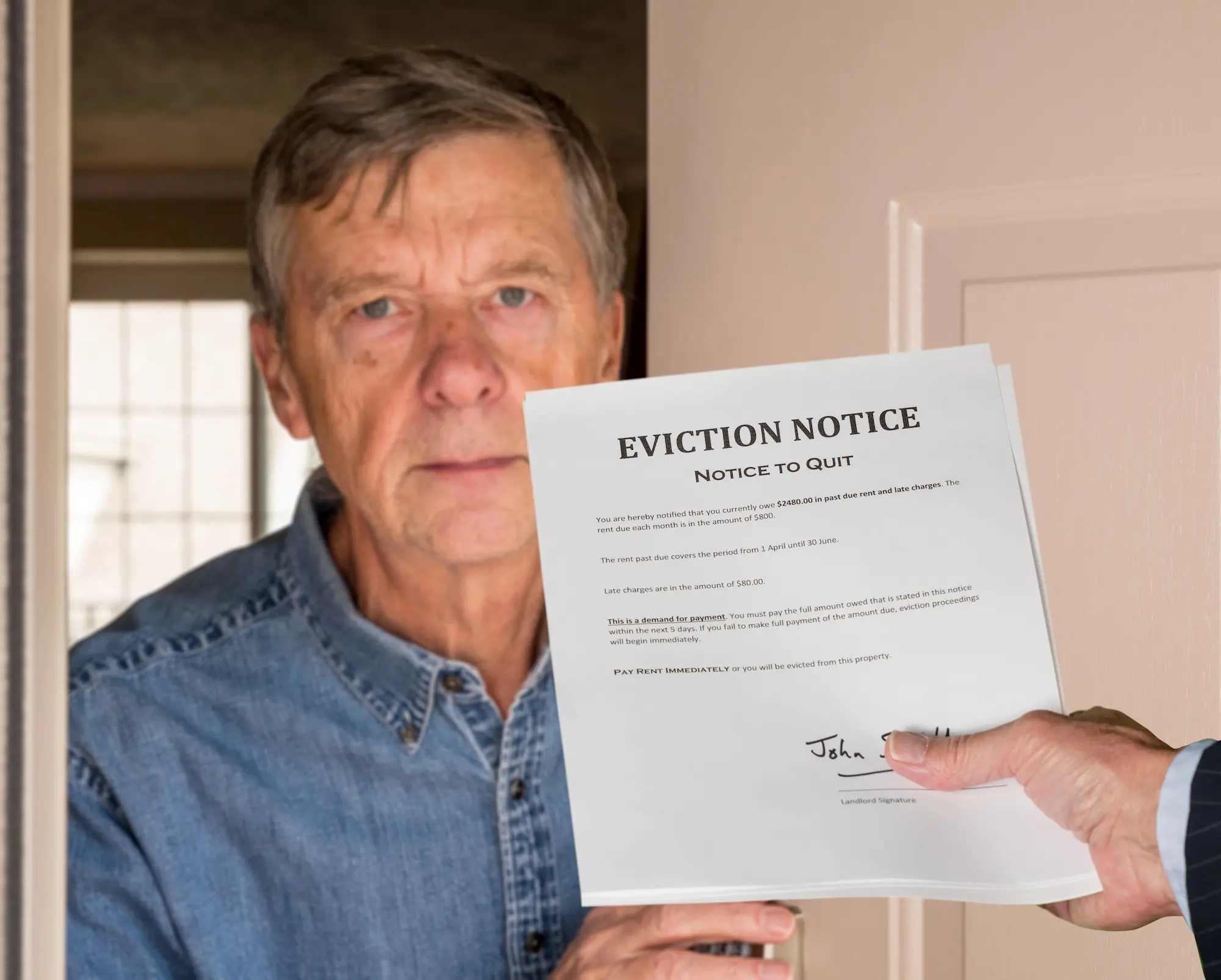Dealing with a tenant who stops paying rent or violates the lease can jeopardize your property, lead to financial losses, and disrupt your timeline. If you act too quickly or overlook a legal procedure, you risk losing your case, delaying recovery, or facing lawsuits. Taking an informed approach allows you to take action and safeguard your investment with minimal disruption.
Key Takeaways
- Make sure your reason for eviction is legally valid and backed by the lease - don't guess.
- Serve the eviction notice correctly and follow your state's legal delivery requirements.
- When filing the lawsuit, double-check all names, addresses, and documents to avoid dismissal or delay.
- Show up to court with organized evidence and present your case factually and professionally.
- Only law enforcement can remove a tenant after a court judgment - doing it yourself is illegal.
Know If You Can Legally Evict
Before serving an eviction notice, ensure your reason is valid and clearly backed by the lease. Acting out of frustration or without solid documentation can lead to a dismissed case or a costly counter-lawsuit.
Not all lease violations justify eviction. A tenant who's late on rent once or makes too much noise on a weekend may be irritating but not legally removable. In contrast, serious issues like repeated nonpayment, property damage, or illegal activity typically give you solid grounds.
Evictions based on retaliation or discrimination, such as removing a tenant for reporting code violations or being part of a protected class, can expose you to significant legal and financial risk under the Fair Housing Act and state laws.
Valid Grounds for Eviction
- Repeated nonpayment or underpayment of rent
- Property damage beyond normal wear and tear
- Illegal activity on the premises (e.g., drug dealing)
- Tenant-caused health or safety violations
- Unauthorized occupants or pets (when the lease prohibits them)
- Refusal to vacate after lease termination or non-renewal
Not Grounds for Eviction (Typically)
- One-time or minor noise complaints
- First late rent payment, especially with communication
- Minor cosmetic wear and tear
- Easily correctable, one-time violations
Pro Tip: If the lease doesn't support your reason for eviction, the court won't either.
Properly Serve the Notice or Risk Dismissal
Once you've confirmed legal grounds, the next step is to formally serve your tenant with a written eviction notice. If the notice is missing details or delivered incorrectly, your case can be dismissed, no matter how justified it is.
Choose the Right Type of Notice
- Pay or Quit: Unpaid rent
- Cure or Quit: Fixable lease violations (e.g., unauthorized pet)
- Unconditional Quit: Serious, non-curable issues (e.g., illegal activity)
Your eviction notice must include:
- Full names of adult tenants
- Property address
- Specific reason for eviction (e.g., "$1,200 rent unpaid for May")
- Deadline to comply (based on state law)
- Your name and signature
Vague language, missing fields, or misdelivery are among the most common tenant defenses, and judges often side with the tenant if the notice isn't legally sound.
How to Serve the Notice Legally
Delivery methods vary by state, so always confirm your local rules, but acceptable options typically include:
- Personal service: Handing it directly to the tenant
- Substituted service: Leave it with an adult occupant and mail a copy
- Conspicuous posting: Taping it to the door and mailing it (only as a last resort)
After serving the notice, complete a proof of service form documenting the time, date, method, and person who delivered it. This will be required when you file your case in court.
Mistakes That Can Invalidate Your Notice
- Serving via text or email (unless your state explicitly allows it)
- Entering the unit without permission to post the notice
- Verbally notifying the tenant
- Accepting partial payment after a Pay or Quit notice (without a written non-waiver)
- Threatening or harassing the tenant during delivery
Pro Tip: Treat the notice like courtroom evidence. It won't hold up if it's not flawless and properly served.
File the Lawsuit Carefully or Risk Starting Over
If your tenant does not comply with the eviction notice, the next step is to file an eviction lawsuit, commonly called an "unlawful detainer" or "forcible entry and detainer." Make sure to file in the correct court based on your property's location, typically the local civil, housing, or magistrate court. Filing in the wrong court may result in automatic dismissal of your case.
To start the case, submit a complaint or petition that includes:
- Full names of the landlord and tenant
- Property address
- Legal reason for eviction
- Copies of the lease, eviction notice, and proof of service
You'll also need to pay a filing fee, which varies by jurisdiction. After filing, the court will issue a summons and assign a case number.
A sheriff, marshal, or licensed process server must formally serve that summons. If service is done incorrectly or by the wrong person, your entire case can be tossed, no matter how solid your claim is. Track when, how, and by whom the papers were served, which is proof that will be required by the court.
Avoid These Common Filing Mistakes
- Filing in the wrong court: Before filing, verify the correct jurisdiction (e.g., county civil court, housing court) for eviction cases.
- Incorrect or incomplete forms: Double-check all names, addresses, and dates against your lease and notice.
- Missing required documents: Create a checklist of what your court requires (e.g., a copy of the lease, the eviction notice, and proof of service for the notice).
- Improper service of the summons: Use a legally authorized person (sheriff, registered process server) for service and obtain a valid proof of service for the court.
- Incorrect filing fee: Confirm the current filing fee with the court clerk's office before submitting your paperwork.
Pro Tip: Eviction cases fail more from paperwork errors than tenant defenses. Slow down, verify every line, and file it right the first time.
Watertight Case for a Favorable Judgment
Preparing for your court hearing is crucial for winning your case. Organize your evidence, including the signed lease, rent ledger, notices, tenant communications, property damage photos, and witness statements. Create three complete sets: one for you, one for the judge, and one for the tenant. A well-structured presentation conveys professionalism and credibility.
On the hearing day, arrive early and dress professionally, addressing the judge as "Your Honor." Present your case calmly and clearly, focusing on the facts of the eviction, like unpaid rent or lease violations, and back claims with documentation. Be prepared for tenant defenses, such as improper notice or retaliation, and respond with evidence. If the tenant is absent, present your case clearly and request a default judgment. Preparation is key to securing judgments.
Testifying Tips That Win Cases
- Be Prepared: Know your case inside out. Have all documents organized and easily accessible.
- Be Punctual and Professional: Arrive early, dress appropriately, and be respectful to the judge, court staff, and the tenant.
- Speak Clearly and Concisely: Straightforwardly present your facts. Avoid jargon or overly complex language.
- Stick to the Facts: Only discuss issues relevant to the eviction grounds. Don't bring up unrelated grievances.
- Use Your Evidence: Refer to your documents (lease, notices, photos) when explaining your case (e.g., "As shown in Exhibit A, the lease agreement…").
- Stay Calm and Composed: Even if the tenant makes accusations, remain calm. Respond factually, not emotionally.
- Listen Carefully: Pay attention to the judge's questions and the tenant's statements so you can respond appropriately.
- Answer Truthfully: Always provide honest answers to any questions from the judge.
Pro Tip: Judges notice preparation. Show up organized, stay focused, and let your evidence speak for itself.
Enforce the Eviction Judgment Legally
Once the court rules in your favor and issues a judgment for possession (and possibly unpaid rent), the tenant must vacate the property by a specific date. But don't assume they'll leave on their own. You cannot change the locks, remove their belongings, or take any enforcement action, which qualifies as an illegal "self-help" eviction. In many states, tenants can sue for damages, including multiple months of rent, court costs, and attorney's fees.
If the tenant doesn't leave by the deadline, obtain a Writ of Possession from the court, which allows law enforcement to perform the eviction. Pay the fee and take the writ to the sheriff or marshal to schedule the lockout. They'll post a notice on the tenant's door, warning them 24-48 hours before removal. Avoid rushing the process, and follow your state's rules for any abandoned belongings to prevent legal issues.
Steps to Take After Receiving an Eviction Judgment
- Review the Judgment Carefully: Understand all terms, including the move-out date and any monetary awards.
- Wait for the Move-Out Deadline: Give the tenant the full time specified in the judgment to vacate voluntarily.
- Obtain a Writ of Possession (if necessary): If the tenant doesn't leave, promptly apply for the writ from the court clerk.
- Coordinate with Law Enforcement: Deliver the writ to the sheriff/marshal and schedule the physical eviction. Do not attempt to remove the tenant yourself.
- Be Present (or have an agent present) at the Lockout: This is often required so law enforcement can return possession to you, and you can secure the property (e.g., change locks) immediately after.
- Handle Abandoned Property Legally: Research and follow state and local laws regarding the storage, notification, and disposal of any belongings left behind by the tenant.
- Document Everything: Keep copies of the judgment, the writ, communications with law enforcement, and records of how abandoned property was handled.
Pro Tip: You won in court - don't lose on enforcement. Let the sheriff handle the lockout.
Use Documentation to Defend Against Disputes
Even after the tenant moves out, your paperwork still matters. Detailed records throughout the tenancy and eviction process are your best defense against deposit disputes, damage claims, or legal challenges. When deducting from a security deposit, back it up with clear evidence, dated photos, move-in and move-out videos, and repair receipts. Vague claims like "cleaning" or "repairs" without itemization often won't hold up in court.
Most states require you to send tenants a written, itemized list of deductions and return the remaining deposit within a specific timeframe, typically 14 to 30 days. If you miss that deadline, you could be on the hook for more than the full deposit, including penalties or even triple damages.
Essential Records to Keep About Each Tenant
- Signed Lease Agreement: Including any addenda or modifications.
- Tenant Correspondence: Letters, emails, and notes of important phone calls.
- Rent Payment Ledger: Full payment history and outstanding balances.
- Notices Served: Eviction notice, court summons, and proof of service.
- Court Documents: Eviction complaint, judgment for possession, and Writ of Possession.
- Inspection Reports: Move-in/move-out checklists, with supporting photos/videos clearly dated.
- Repair Invoices and Receipts: For any damages deducted from the security deposit.
- Security Deposit Itemization: Copy the itemized list of deductions and proof of how the balance (if any) was returned.
Pro Tip: If you can't prove it with photos, receipts, or dates, assume the court won't back you up.
Conclusion
Eviction is not about punishment. It's about reclaiming control of your property while following the law. By following these steps carefully, staying organized, and avoiding shortcuts, you'll protect your legal position and income. With proper screening, clear lease terms, and good communication, you may avoid needing to evict at all.









